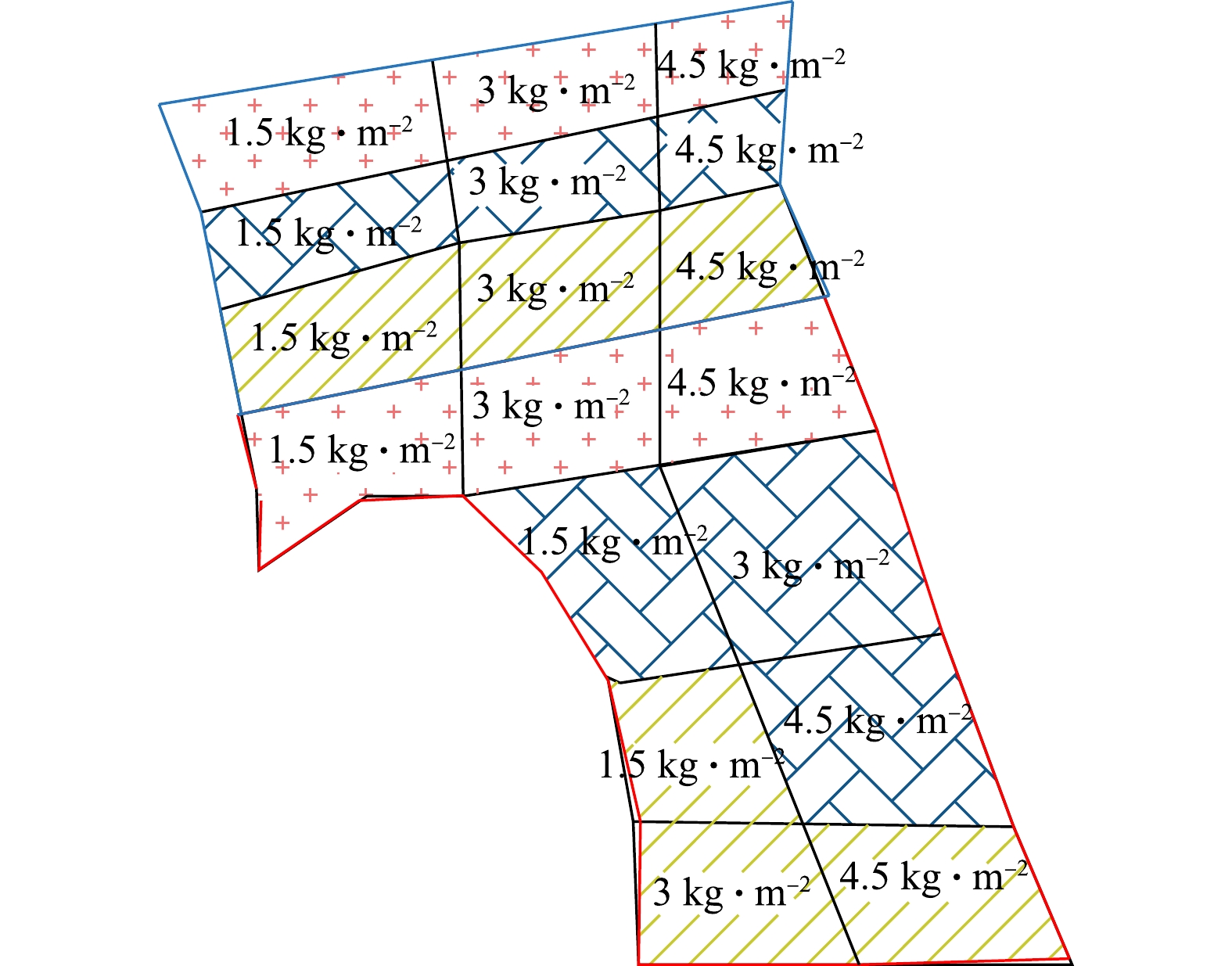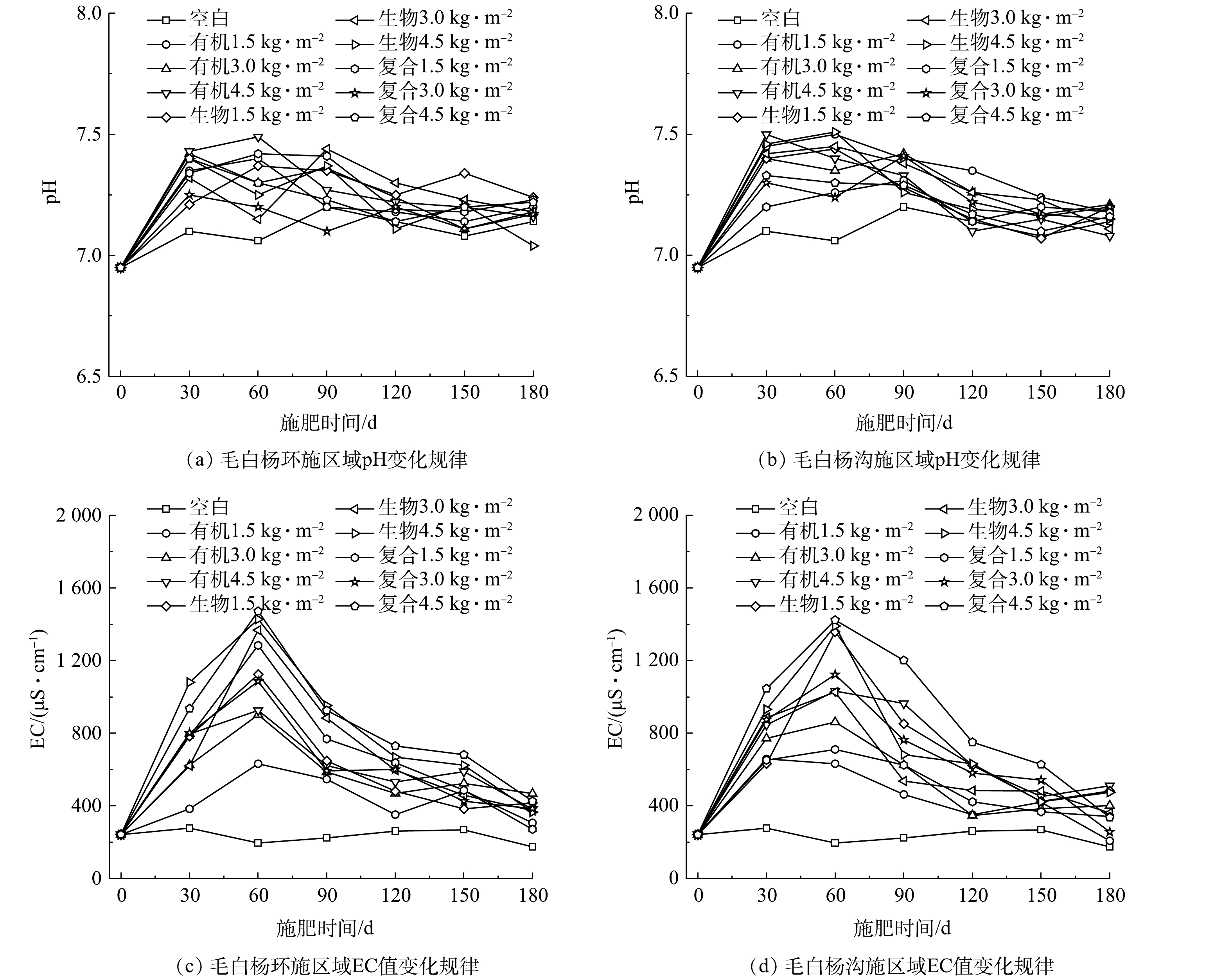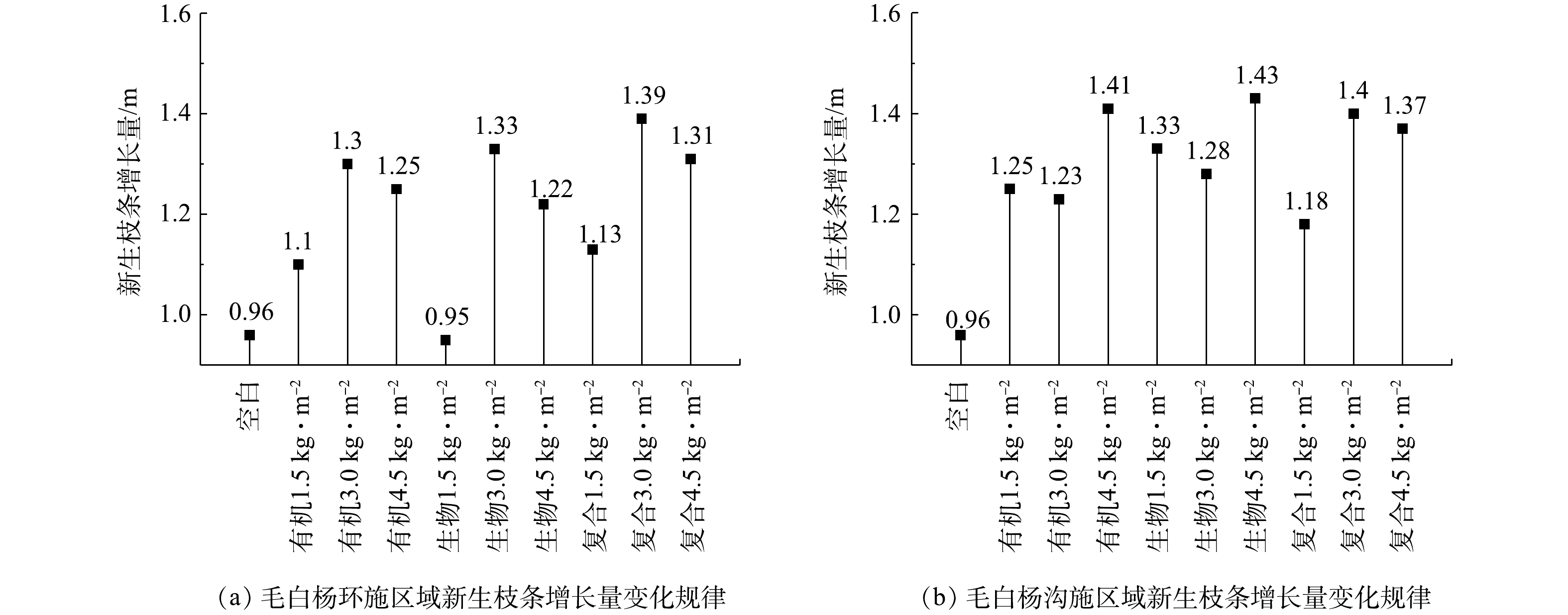-
随着城市污水处理量的日益增多,伴随产生的大量剩余污泥已成为亟待处理的固体废物[1]。截至2017年6月底,全国共有城镇污水处理厂4 063座,每年产生城市污泥近5×107 t(含水率80%)[2]。据统计[3],2020年城市污泥产量将突破6×107 t(含水率80%)。根据城市污泥富含氮、磷、钾、有机质的特点,可将其作为肥料进行土地利用。其中,林地利用较农用风险低,消纳污泥容量大(我国林地面积达1.7×108 m2),已逐渐成为污泥处置的主要方向之一[3]。
自20世纪60年代起,英、美等发达国家就将污泥作为高效的有机肥料,广泛应用于林地[4]。我国自20世纪80年代起,也开展了污泥林地利用方面的研究。唐艺荣[5]研究发现,城市污泥中含有大量营养成分,能够很好地促进植物生长,特别是在一些持水性差、生产能力低的土壤上效果更加明显。白莉萍等[6]在北京选择林地施用城市污泥,发现施肥可使土壤中氮、磷含量显著增加,且能促进植物和微生物的生长和代谢。但是,目前关于城市污泥不同的施用量和施用方式对施用效果影响方面的研究较少。本研究通过现场实验,以3种污泥产品作为研究对象,采用不同的施肥方式和施用量,监测施肥土壤中营养物质含量的变化,结合植物生长的情况,确定最佳的施肥方案;并对示范区土壤和地下水中重金属含量进行检测,通过环境评价法探讨城市污泥产品林地施用对土壤和地下水环境的影响。
全文HTML
-
供试的3种城市污泥产品均来自北京市排水集团,包括有机营养土(热水解污泥)、生物碳土(堆肥污泥)和复合生物碳土(堆肥污泥与园林废弃物混合),其理化性质见表1。
-
本研究选择在北京市大兴区北臧村镇赵家场村建立污泥产品林地利用示范区。示范区占地面积为1×105 m2,种植银杏、毛白杨、白皮松、紫花洋槐、国槐等8种树木,为北京市百万亩平原造林场地,示范区平面图如图1所示。
根据实验需要,在毛白杨区域内划分场地作为实验区域,实验区规划如图2所示。将实验区域划分18个样方地块。采用沟施和环施2种施肥方式,施用有机营养土、生物碳土和复合生物碳土3种城市污泥产品,施肥量分别为1.5、3.0和4.5 kg·m−2(以污泥干基计)。另设不施肥的空白对照组。沟施均在树的右侧距离树木主干80~100 cm处开沟,沟宽度30 cm,深度40 cm,施肥后立刻覆土,覆土厚度不低于20 cm;环施在树木的2旁距树干80~100 cm处开挖环施沟,深度为30 cm,宽度30 cm。将城市污泥产品施入穴中后覆盖土壤,覆土厚度不低于20 cm。施肥现场如图3所示。
-
1)样品采集。于2019年3月、7月、8月、9月、10月、11月、12月进行土壤样品、植物样品及水样的采集;2019年6月12日完成全部的施肥工作。示范区域与实验区域的土样选择梅花形布点进行采集。测量实验样方树木的株高与树径,选择数值最接近平均值的标准株作为监测植物生长情况的采样树。
2)样品分析。土壤基本理化性质参照《土壤农化分析》[6]测定;毛白杨叶绿素使用便携式叶绿素仪现场检测;毛白杨新生枝条增长量根据芽鳞痕确定当年新生枝条,现场测量新枝长度。
土壤重金属含量[7]测定:精确称取土壤样品0.1 g置于消解管中,用少量水润湿,在通风橱中依次缓慢加入6 mL浓盐酸、2 mL浓硝酸、1~2 mL氢氟酸;加盖置于微波消解转盘上,采用梯度升温的方法进行消解;微波消解后取出,待管内温度降至室温后,将消解后的混合液过滤定容至50 mL,于4 ℃下保存。取出10 mL待测液进行ICP-MS检测。
-
1)单因子评价法。单因子评价计算公式[8]如式(1)所示。
式中:Ci为污染物i在土壤中的含量,mg·kg−1;Si为污染物i在土壤中的质量标准值;i为GB 15618-2018中规定的各类重金属污染物。
将各类污染物i的相关值代入公式(1)进行计算得到Pi值。当Pi值小于0.7时,则认为在该指标方面不存在环境污染;当Pi值大于0.7小于1时,则认为该指标已达到警戒限,后续应慎重施用污泥产品;当Pi值大于1时,则认为该指标存在一定的环境影响,应立即停止后续污泥产品的施用。
2)潜在危害指数法。潜在生态危害指数法评价公式[9]如式(2)所示。
式中:EIi为污染物i的潜在生态风险指数;Ti为污染物i的生物毒性响应系数;Ci为土壤重金属i的环境暴露值;Si为污染物i的参比值,本研究参比值选择GB 15618-2018规定的重金属风险筛选值;i为GB 15618-2018中规定的各类重金属污染物。
将各类污染物i的相关值代入公式(2)进行计算得到EI和RI值,参照风险等级标准[9](表2)进行评价。
1.1. 供试材料
1.2. 实验设计
1.3. 样品采集与分析方法
1.4. 环境影响评价方法
-
1)城市污泥产品施用对土壤pH、EC值的影响。城市污泥产品在林地施用后,各实验样方内土壤pH和EC值的变化如图4所示。由图4(a)和图4(b)可知,由于施用的污泥产品呈弱碱性,施肥30 d后土壤的pH呈明显上升状态。有研究表明,土壤酸碱度为6.5~7.5时,适宜园林植物的生长[10]。在90 d后,土壤pH开始下降,这主要是由于夏季雨水充足,土壤中的盐基离子受到雨水冲刷而淋失,使土壤中易溶性盐分减少。在施肥4个月后,土壤pH趋于稳定。在整个监测过程中,土壤的pH>7,且施肥土壤的pH高于空白区域,这说明污泥产品在施用过程中没有产生过多的酸性物质,能够改善土壤的酸碱度,这有利于植物的生长。
电导率是反映土壤中可溶性盐分含量的指标,也是反映土壤理化性质的重要指标之一[11]。由图4(c)和图4(d)可以看出,土壤电导率受到施肥的影响较大,而且会随施肥浓度的增加而升高。由表1可以看出,3种污泥产品本底的EC值较高,均在2 000 μS·cm−1以上。AMIR等[12]的研究表明,当土壤EC值超过3 000 μS·cm−1时,有可能对植物的生长造成抑制。当施肥时间达到60 d时,林地土壤EC值达到极值点,此时施用量为4.5 kg·m−2地块的土壤EC值均超过1 200 μS·cm−1;施用复合生物碳土的样方土壤中EC值最高达到了1 457 μS·cm−1,但尚未产生盐度风险。60~120 d,土壤EC值迅速下降,其主要原因包括3个方面:一是土壤中部分无机离子在微生物的作用下转化成有机物;二是夏季草本植物的迅速生长,从土壤中吸收了大部分可溶性离子;三是随着雨水的冲刷,大部分盐基离子随水淋失,土壤含盐量降低进而降低了土壤的电导率[13]。随着实验的不断进行,土壤EC值逐渐下降并最终稳定在200 μS·cm−1左右。
2)城市污泥产品施用对土壤养分的影响。不同施肥方案下土壤中总氮随时间的变化规律如图5所示。在为期6个月的监测周期内,各样方土壤中总氮含量呈现先上升后下降的变化趋势。2019年7月(施用污泥产品1个月后),土壤中的总氮含量达到最大值;通过对比发现,此时施用有机营养土的效果较好,在施用量为4.5 kg·m−2时,土壤中总氮含量可达0.71 g·kg−1,相较于总氮本底值增加了238%。2019年9月,部分样方内总氮含量再次上升。其原因可能是氮素的缓释效果,以及秋天植物凋落,通过微生物对落叶的分解增加了土壤中总氮的含量。而且这一时期可明显看出,土壤总氮含量随施肥量的增大而增大,以此时毛白杨环施区为例,当施用的污泥产品分别为有机营养土、生物碳土和复合生物碳土且施用量为4.5 kg·m−2时,土壤中总氮的含量分别是不施肥土壤的1.31倍、1.05倍和1.84倍,施用复合生物碳土的效果明显好于其他2种污泥产品。其原因可能是,园林废弃物与堆肥污泥含量混合后,提高了污泥产品的C/N,进而影响氮的矿化[14]。在实验的后期,各施肥区土壤总氮含量均高于未施肥的空白区域,施用污泥产品确实起到了良好的效果。
磷是土壤中重要的营养元素,也是植物核酸、核蛋白和磷脂的主要组分。施用城市污泥产品后,土壤总磷含量随时间变化规律如图6所示。在2019年的7、8月各样方土壤中总磷含量变化不明显,仅施用4.5 kg·m−2复合生物碳土的区域上升幅度最大,在第60 d时环施区、沟施区的总磷含量分别是空白对照组的2.18、2.17倍。这主要是由于污泥堆肥中的磷元素比较稳定,短时期内无法释放到土壤中,而且在此季节树木和草本植物迅速生长,吸收了部分磷。9月土壤中总磷含量大幅度上升,主要因为进入秋季,植物长势减缓,降水明显减少,且污泥中磷的存在形态从不易矿化分解的大分子转变为易矿化分解的形态,矿化的磷和无机磷被土壤快速吸收[15]。11月实验区土壤磷含量出现下降并于12月再次上升。在整个实验周期内,大部分施肥土壤中总磷含量高于未施肥土壤,说明施用城市污泥产品效果显著。通过分析实验区土壤磷含量的变化趋势发现,在不同的采样时间,施用复合生物碳土的样方中总磷含量均高于施用有机营养土和生物碳土的区域,且施用量越大效果越好,这说明污泥与园林废弃物混合后可以提高综合堆肥效果,有助于污泥中磷元素的释放。
有机质的含量可以直观反映土壤的肥沃程度,是评价土壤肥力的重要指标之一。由6个月的监测结果(图7)可以看出,土壤中有机质的含量与施肥量呈正比,且复合生物碳土的施用效果较其他2种污泥产品更好,这与总氮和总磷的研究结果相符合。在施用污泥产品2个月内,各施肥样方土壤中有机质含量均出现上升,即使在夏季,植物对有机质的吸收较多的情况下,土壤有机质含量的提升效果依然明显。以2019年8月(施肥2个月)环施区为例,施用4.5 kg·m−2的有机营养土、生物碳土和复合生物碳土的样方内土壤有机质含量分别是空白区的1.32倍、1.33倍、1.61倍。在90 d时,有机质含量出现明显下降,并在同年11月再次下降。导致这一现象的原因可能是,此时污泥产品中的有机质在土壤酶的作用下被分解,生成的某些简单组分如碳水化合物等较快的分解,最终变成水、二氧化碳和矿物质养分使得有机质含量减少[16]。2019年12月(施肥6个月),施肥与未施肥土壤的有机质含量均略有上升。其原因可能是,进入冬季,植物生长变缓,植物的落叶被微生物分解腐化,使所有样方内有机质含量呈现出缓慢上升的趋势。
-
1)城市污泥产品施用对叶片叶绿素含量的影响。城市污泥产品施用后,可以为植物生长提供养分。植物的叶绿素含量可以及时反映出植物生长的好坏。通过沟施、环施两种施肥方式施用污泥产品后,毛白杨叶绿素含量的变化如图8所示。施用污泥产品后,毛白杨叶绿素出现了明显的上升。与施肥60 d相比,在施肥第90天,由于进入秋季,植物叶绿素含量开始下降;但能够明显看出,施肥区植物的叶绿素含量在此时均高于未施肥的空白区域,施用污泥产品可以很好的提高植物叶绿素的含量进而延长植物绿期。
2)城市污泥产品施用对新生枝条增长量的影响。植物当年新生枝条增长量(图9)可以较为明显地反映出植物在1年内生长的情况。通过现场监测发现,施肥区的毛白杨枝条增长量明显高于未施肥的空白区,在施用量为3 kg·m−2时植物生长效果最好。毛白杨环施区和沟施区的新生枝条增长量较空白区平均增长了0.26 m和0.33 m,说明施用污泥产品能够明显的促进植物生长。
-
1)污泥产品种类对重金属含量的影响。根据《城镇污水处理厂污泥处置林地用泥质》(CJ/T 362-2009)[17]相关规定,污泥产品每年累计施用量不应超过3 kg·m−2(以干污泥计)。因此,以实验区域内施用量为3 kg·m−2样方的监测数据为例,利用单因子评价法,参考《土壤环境质量标准农用地土壤污染风险管控标准》中的风险筛选值进行评价。
城市污泥产品施用8种重金属的Pi值随时间的变化如图10所示。在整个监测周期中,铬、镍、铜、锌、汞、镉、铅、砷八种重金属的Pi值均低于0.7,说明污泥施用后的土壤中重金属含量均未超过《土壤环境质量标准农用地土壤污染风险管控标准》中的风险筛选值。由图10看出,重金属铬、镍、铅的变化规律类似,均呈现出先上升后下降再上升的趋势;铜、锌施用后含量先上升后基本保持稳定;砷、镉、汞均呈现出先上升后下降的趋势尤其是汞在实验后期已恢复到未施肥前的水平,超标风险很低。
2)不同施肥方式和施肥量对土壤重金属含量的影响。根据前文的研究结果,选择重金属镍、锌、砷、汞作为监测对象,探讨不同施肥方式和施肥量对其含量的影响。4种重金属含量随时间变化如图11所示。可以看出,实验区域土壤中4种重金属的变化规律与撒施区域一致。土壤中锌含量在实验初期上升后略有下降并最终趋于稳定。施用污泥使土壤中锌含量出现了一定的累积。以施用4.5 kg·m−2有机营养土、生物碳土和复合生物碳土的样方为例,土壤中锌含量分别为34.2~79.33 mg·kg−1、26.73~71.38 mg·kg−1和25.73~85.97 mg·kg−1。施肥后,汞和砷均呈现出先上升后下降的趋势,其中汞含量最高达到了0.185 mg·kg−1,随后便出现了下降;施用复合生物碳土的样方内土壤砷含量略高于施用其他2种污泥产品的地块,并在施肥后90 d时达到最大值。以毛白杨环施区为例,施用量为1.5 kg·m−2、3 kg·m−2和4.5 kg·m−2时,其土壤砷含量分别为13.23 mg·kg−1、18.29 mg·kg−1、16.06 mg·kg−1。施用城市污泥产品后,土壤镍含量并未出现明显的积累,而是呈现出先上升后下降再上升的变化规律。通过6个月的连续监测,4种重金属含量均低于《土壤质量标准农用地土壤污染风险管控标准》中风险筛选值的要求,超标风险较低。
3)潜在生态风险评价。在单因子评价结果的基础上,应用潜在危害指数法进行后续评价,综合毒性水平、污染浓度及环境对重金属的敏感性,来判断施肥后对土壤的整体污染程度[18]。
由图12可以看出,综合生态风险指数RI值均远小于150,各重金属的EI值均小于40,表明施用城市污泥产品后土壤重金属含量处于低风险状态,但施肥后各段时间内土壤重金属RI值均高于土壤本底值,说明污泥的施用会导致土壤中重金属的累积。在城市污泥产品施用初期,施肥地块RI值明显升高,此时施用生物碳土的土壤潜在生态风险最高,其RI值达到了27.4,而施用复合生物碳土和有机营养土的地块RI值为23.7和14.5。随着时间的推移,重金属潜在生态风险逐渐减小[19],在实验后期施肥区与空白区的RI值基本持平。通过实验发现,镉的潜在风险贡献率最高达到了67.2%,需要重点关注。综上所述,在本研究条件下施用城市污泥产品的土壤潜在生态风险较低,但需重点关注镉和汞的含量变化,避免对土壤环境造成影响。
2.1. 城市污泥产品施用对林地土壤理化性质的影响
2.2. 城市污泥产品施用对毛白杨生长的影响
2.3. 城市污泥产品施用对土壤重金属含量的影响及风险评价
-
1)城市污泥产品施用后,对土壤的理化性质起到了一定的改良作用。
3)综合城市污泥产品施用后土壤营养物质含量变化及植物生长情况,发现施用3 kg·m−2复合生物碳土的效果最佳,且施用方式对土壤营养元素含量的影响不明显。
3)施肥土壤中各类重金属含量均处于低风险状态;施用城市污泥产品后短期内不会对土壤造成重金属污染。




 下载:
下载:













